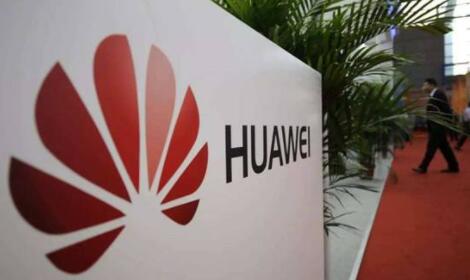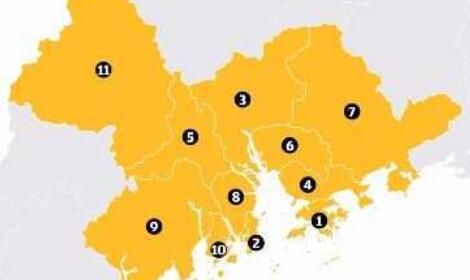福布斯文章称日本将领导东亚,而不是中国,你的看法呢? [巴基斯坦媒体]
巴基斯坦网友:未来几年,中国将面临严重的问题…这些问题将使中共的统治受到压力。然而日本似乎离这个地位很远。它的人口规模不到中国的十分之一(不仅仅是老龄化问题…它的人口还在萎缩)。日本的债务与GDP之比也超过229%。那么,在未来的25年里,日本将如何成为东亚最强大的国家呢?......
The Leading Power In East Asia Will Be Japan -- Not China
东亚的主导力量将是日本,而不是中国
China will face serious problems in coming years… problems that will strain the Communist Party’s rule.
Japan, though, seems a bridge too far. Its population is less than a tenth of China’s size (and it’s not just aging… it’s shrinking). Japan also has a debt-to-GDP ratio over 229%.
So, how is it that Japan will emerge in the next 25 years as East Asia’s most powerful country?
A good place to start is a broad comparison of the structure of China and Japan’s economies (the second and third largest economies in the world, respectively).
This analysis will reveal strengths and weaknesses for both and will bring our forecast into sharper relief.
A look at China’s economy by region
The map below divides China into four geographic regions by contribution to national GDP. The data come from China’s National Bureau of Statistics. China sometimes uses these divisions to understand how the economy is performing at a regional level. (It must be noted that these figures are likely manipulated for political purposes.)
The data contain notable discrepancies, in spite of which it still reveal much about China’s economic weaknesses.
The coastal Eastern Region accounts for more than half of all economic activity in China. The Central and Western regions each produce about 20% of China’s economic wealth. But let’s take a closer look.
The Western Region makes up more than half of China’s total land area. When compared to other regions, it produces less than half of what the Eastern Region does. And it produces the same amount as the Central Region, which is less than half its size.
The Northeastern Region appears to be an outlier. It accounts for just 8% of China’s GDP. Most of this region’s economic activity is heavy industry and has been under severe pressure as China attempts to increase internal demand and decrease dependence on exports.
What does this mean in practical terms?
Poverty is China’s greatest weakness
China’s biggest economic weakness… and its most potent enemy… is poverty. Regional economic disparities exist in many countries in the world. But in China, they have always been particularly acute.
China’s sheer size magnifies this problem.
In 1981, roughly 1 billion Chinese people lived on less than $3.10 a day (at 2011 purchasing power parity). The World Bank’s latest data (from 2010) show that the number dropped to 360 million that year.
That is a great accomplishment. The problem is that it is not enough.
China has been growing at a remarkable rate for the past 30 years, but that growth is slowing down. 360 million people still live in abject poverty.
The map shows us that most of China’s economic success is enjoyed by the coast… not the rest of the country.
China’s double-edged sword
China is the most populous country in the world and the fourth largest in terms of area. This is a source of great power, but it is also a double-edged sword.
There are great advantages. China can deploy huge armies. It is buffered from enemies by vast territory or harsh geography on all sides. It can also mobilize human capital like no other country.
On the other hand, it means that China often spends more on internal security than it does on the much-vaunted People’s Liberation Army. It also rules over many regions that are not ethnically Han Chinese… regions that want greater autonomy (if not independence). And China must maintain a robust capability to guard its borders.
China is a formidable land-based power, but it has never been a global maritime power. It has always been susceptible to internal revolution, and at times, external conquest.
Now, let’s look at Japan.
Wealth concentration in Japan
At first glance, this map of Japan (below) seems to imply a similar level of wealth concentration in certain regions. Like China, Japan is informally divided into regions and sometimes reports data at the regional level.
Japan is made up of four main islands: Kyūshū, Shikoku, Honshu, and Hokkaido.
Kyūshū, Shikoku, and Hokkaido constitute regions of their own. Honshu (the largest and most populous of the Japanese islands) is subdivided into five additional regions.
These five Honshu regions account for 87% of the Japanese economy. (About 43% of that economic activity comes from the Kantō Region’s seven prefectures.)
This map also separates Tokyo prefecture from the others to provide a sense of how much it contributes to Japan’s total GDP. Tokyo prefecture (by itself) accounts for just over 18%.
Factoring in the Tokyo greater metropolitan area increases this figure. According to the latest available data from the Organisation for Economic Co-operation and Development (from 2012), Tokyo had the largest GDP of any city in the world at $1.48 trillion. (Seoul was second with a GDP of less than half of that.)
That means that greater Tokyo accounts for almost a third of Japan’s total GDP.
Japan’s advantage
Unlike China, Japan’s wealth is spread much more evenly among its population. On the simplest level, this is easier to accomplish with a population of 127.3 million than with a population of 1.3 billion.
But this is not strictly about size. What holds China back is the diversity that results from its size.
Japan does not have to deal with the type of coastal versus interior diversity that China does.
In the China example, almost every coastal province could be compared with an interior province and a similar gulf would exist. In Japan, only Tokyo is significantly above the mean per capita income of 3.1 million yen for the entire country, and that is due, in part, to the higher cost of living in the city.
There is wealth disparity in Japan to be sure, but the disparity is not on the same scale as that which exists at the provincial level in China.
Japan’s greatest challenge
Japan’s great weakness is its dependence on imports for food and raw materials. The country’s total food self-sufficiency ratio based on calorie supply was just 39% in 2015. Based on production value, it was just 66%.
Japan relies almost entirely on imports for staples like wheat, barley, corn, and soy.
Energy is another example of this dependence on imports. One of the main reasons Japan entered World War II was to protect its access to oil.
Today, Japan is still reliant on foreign sources of energy. Even before the Fukushima nuclear reactor accident in 2011, Japan relied on foreign sources for close to 80% of its energy supply.
Since 2012, that number has risen to almost 91% (according to the US Energy Information Administration).
Some will argue that Japan’s bigger problem is demographics. It is true that Japan has a rapidly aging population. But so does China. Most European countries also face this issue.
But Japan has options
Japan is one of the top investors in the world in artificial intelligence research, automation, and robotics technology in order to maintain productivity.
And while Japanese society is homogenous and relatively unfriendly to outsiders, desperate circumstances could call for desperate measures and necessitate changing policies on immigration.
The broader Asia-Pacific region also offers opportunities for Japan to find workers to address this problem.
A final comparison
Japan is the 62nd largest country in terms of area. It is the 11th largest in terms of population. But neither of these facts disqualifies Japan from rising as a regional power.
Unlike China, Japan has no land-based enemies—it is an island nation. Unlike China, the Japanese government has no concern about its ability to impose its writ throughout the entire country.
Nor does it have to deal with a huge gulf in wealth disparity between regions. Japan has also managed a transition from a high-growth economy to a low-growth economy without revolution.
Japan’s weaknesses have manifested in the development of a strong navy able to guard maritime supply lines. It has also cultivated a tight alliance with a country that will guard those supply lines, the United States.
To be clear, China is still a very powerful country relative to most in the world. As such, much of our writing remains focused on understanding how economic problems in China are manifesting in political challenges.
For now, Japan is less dynamic and important… though it will become more so… and our writing on Japan will increase as it becomes the leading power in the Asain Pacific.
未来几年,中国将面临严重的问题…这些问题将使T·G的统治受到压力。
然而日本似乎离这个地位很远。它的人口规模不到中国的十分之一(不仅仅是老龄化问题…它的人口还在萎缩)。日本的债务与GDP之比也超过229%。
那么,在未来的25年里,日本将如何成为东亚最强大的国家呢?
一个良好的开端是对中国和日本经济结构的对比(分别是全球第二和第三大经济体)。
这一分析将揭示两国的优缺点,并将使我们的预测更加清晰。
分地区看中国经济
下面的地图按其对GDP的贡献将中国划分为四个地理区域。这些数据来自中国国家统计局。中国有时会利用这些划分来理解经济在地区层面上的表现。(必须指出,这些数字很可能是出于政治目的而被操纵的。)
这些数据包含了显着的差异,尽管它仍然揭示了许多中国经济的弱点。
东部沿海地区占中国经济活动的一半以上。中部和西部地区各自产生约20%的中国经济财富。但是让我们仔细看看。
西部地区占中国陆地总面积的一半以上。与其他地区相比,西部地区的产出不到东部地区的一半。它的产出和中部地区相同,然而中部地区的面积还不到它的一半。
东北地区似乎是个例外。它只占中国GDP的8%。该地区的大部分经济活动都是重工业,在中国试图增加内需、减少对出口的依赖之际,这一地区面临着巨大的压力。
这实际意义上意味着什么?
贫穷是中国最大的弱点
中国最大的经济弱点…和最强大的敌人…是贫穷。世界上许多国家都存在地区经济差距。但在中国,这个问题一直特别尖锐。
中国庞大的规模放大了这一问题。
1981年,大约10亿中国人每天的生活费低于3.10美元(按2011年购买力平价)。世界银行的最新数据(2010年)显示,这一数字在当年下降到了3.6亿。
这是一项伟大的成就。问题是,这还不够。
在过去的30年里,中国一直在以惊人的速度增长,但增长正在放缓。3.6亿人仍然生活在赤贫之中。
这张地图告诉我们,中国经济的大部分成果都是由沿海地区享受的,而不是中国的其他地方。
中国的双刃剑
中国是世界上人口最多的国家,也是面积第四大的国家。这是强国之源,但也是一把双刃剑。
它有巨大的优势。中国可以部署庞大的军队。广阔的领土或四面八方严酷的地形对敌人形成了缓冲。它还可以以其他国家无可比拟的优势调动人力资源。
另一方面,这意味着中国在国内安全上的花费往往比其大肆吹嘘的PLA花费要多。它还统治了许多非汉族地区…这些地区希望获得更大的自治权(如果不是独立的话)。中国必须保持强大的能力来保卫自己的边境。
中国是一个强大的陆上强国,但从未成为全球海上强国。它总是容易受到内部革命的影响,有时还会受到外部的征服。
现在,让我们来看看日本
日本财富集中度
乍一看,这幅日本地图似乎暗示了某些地区的财富集中度与中国类似。与中国一样,日本也被非正式地划分为几个区域,有时在区域层面上报告数据。
日本是由四个主要岛屿组成:九州,四国,本州,北海道。
本州岛(日本最大和人口最多的岛屿)被细分为另外五个地区。
这五个本州地区占日本经济的87%。(大约43%的经济活动来自关东地区的七个县。) 这张地图还将东京地区与其他地区区分开来,以说明它对日本总GDP的贡献有多大。东京地区(本身)仅占18%。考虑到东京大都会区的因素,这一数字会增加。
根据经济合作与发展组织最新公布的数据(2012年),东京拥有世界最大的城市GDP,为1.48万亿美元。(首尔排在第二位,GDP不到东京的一半。)
这意味着大东京区占日本GDP总量的近三分之一。
日本的优势
与中国不同,日本的财富在其人口中分布更为均匀。从最简单的层面上看,1.273亿人口比13亿人口更容易实现这一点。
但这并不完全是由于规模。阻碍中国发展的是其规模的多样性。日本不必应对像中国的沿海与内陆的多样性问题。
在中国的例子中,几乎每一个沿海省份都可以与内陆省份相比较,类似的分歧也会存在。在日本,只有东京的人均收入远高于310万日元的全国平均水平,这在一定程度上是由于城市生活成本较高。
日本确实存在着贫富差距,但这种差距并不像中国省级存在的那样大。
日本最大的挑战
日本的最大弱点是对进口食品和原材料的依赖。基于卡路里供应的全国食品自给率在2015年仅为39%。按产值计算,仅为66%。
日本几乎完全依赖小麦、大麦、玉米和大豆等主食的进口。
能源是依赖进口的另一个例子。日本参与第二次世界大战的主要原因之一是为了保护其获得石油的通道。
如今,日本仍然依赖外国能源。甚至在2011年福岛核反应堆事故发生之前,日本的能源供应近80%依赖于国外。自2012年以来,这一数字已升至近91%(根据美国能源情报署的数据)。
一些人会说,日本更大的问题是人口问题。的确,日本人口正在迅速老龄化。但是中国也是如此。大多数欧洲国家也面临这个问题。
但是日本有选择
日本是世界上最大的人工智能研究、自动化和机器人技术的投资者之一,以保持生产力。
尽管日本社会是同质的,对外人相对不友好,但绝望的环境可能会要求采取绝望的措施,并要求改变移民政策。
更广泛的亚太地区也为日本提供了寻找工人解决这一问题的机会。
最后的比较
就面积而言日本排在62位,人口排11位。但这两个事实都不能取消日本崛起成为地区大国的资格。
不像中国,日本没有陆地的敌人,它是一个岛国。不像中国,日本政府并不担心其在全国范围内实施命令的能力。
它也不需要解决地区间贫富差距的巨大鸿沟。日本也在没有革命的情况下从高增长经济过渡到低增长经济。
日本的弱点体现在发展一支能够保卫海上补给线的强大海军。它还与一个将保护这些供应线的国家——美国——结成了紧密的联盟。
需要明确的是,中国仍然是一个相对于世界上大多数国家来说非常强大的国家。因此,我们的许多着作仍然侧重于理解中国经济问题在政治挑战中的表现。
就目前而言,日本的活力和重要性都有所下降……尽管它会变得更加有活力和重要……因此我们对日本的着作也将增加,因为它将成为亚洲太平洋地区的主导力量。
DESERT FIGHTER
ELITE MEMBER
Japan is an awesome country.. but not a leader.
Its a country whose balls have been cut off by USA...
日本是个很好的国家。但不是一个领导者。
这个国家被美国切断了……
Iqbal Ali
SENIOR MEMBER
DESERT FIGHTER said: ↑
【Japan is an awesome country.. but not a leader.
Its a country whose balls have been cut off by USA...】
That is where I agree with you. Japan is not a leader. But Japan is technologically advanced though.
And the Japanese are well educated too
我同意日本不是领导者。但是日本在技术上是先进的。
以及日本人受过良好的教育。
DESERT FIGHTER
ELITE MEMBER
That technological edge is eroding fast.
技术优势正在迅速消失。
Iqbal Ali
SENIOR MEMBER
Yes as China rises on the world stage , Japan will become less important. Japan has a population of 127 million people. While China has a population of 1.3 billion people. Population counts as it means how much influence a country can have. Even India has some influence because of its large population.
是的,随着中国在世界舞台上崛起,日本将变得不那么重要。日本有1.27亿人口。中国有13亿人口。人口数量意味着一个国家可以拥有多少影响力。就连印度也因为人口众多而拥有一些影响力。
Cybernetics
FULL MEMBER
Eastern China provinces: Hebei (74 million), Beijing (22 million), Tianjin (15 million), Shandong (99 million), Jiangsu (80 million), Shanghai (24 million), Zhejiang (57 million), Fujian (37 million), Guangdong (109 million), Hainan (9 million)
Eastern China Total: 526 million people (37% of total population)
Eastern China as an aggregate is less than 50% wealthier than the average.
Landmass doesn't equal economic production, most of Western China is desert and highland plateau. Western China provinces: Inner Mongolia (25 million), Xinjiang (24 million), Gansu (26 million), Ningxia (7 million), Shaanxi (37 million), Qinghai (6 million), Sichuan (81 million), Chongqing (30 million), Tibet (3 million), Guizhou (35 million) , Yunnan (46 million), Guangxi (47 million)
Western China Total: 367 million people (26 % of total population)
Western China is about 75% the national average.
Central China provinces: Shanxi (37 million), Henan (95 million), Hubei (59 million), Anhui (60 million), Hunan (67 million), Jiangxi (42 million)
Central China Total: 360 million people (26% of total population)
Central China is about 75% of national average.
North East provinces: Heilongjiang (38 million), Jilin (27 million), Liaoning (44 million)
North East China Total: 109 million (8% of total population)
North East China is at national average. I don't understand what the author means by "just 8% of China's GDP", it is inline with the population proportion.
"Let some people get rich first"-Deng Xiaoping
China is still in the early process of reform and development. For those that travel to China they know how fast the interior is catching up to the coastal regions. Only the North East has slow growth due to structural economic issues. The North East is also experiencing large population outflows.
The coastal and interior difference isn't a economic weakness for China during development. In fact it is what made rapid and sustained growth possible. After investment gets saturated along the coast does it make sense to develop the interior, which is happening now. Had investment been distributed evenly, today's growth wouldn't have been possible. The worst possible method would be to spread investment evenly and not leverage regional advantages to create supply chain clusters. Even development will make future growth weaker. In the long run it would be desirable to pursue even development but due to geographic issues, some regions would be depopulated to raise its per capita income closer to national levels.
中国东部省份:河北(7400万)、北京(2200万)、天津(1500万)、山东(9900万)、江苏(8000万)、上海(2400万)、浙江(5700万)、福建(3700万)、广东(1.09亿)、海南(900万)
东部地区总人口:5.26亿人(占总人口的37%)
中国东部作为一个整体比全国平均富裕不到50%
陆地面积不等于经济产出,中国西部大部分是沙漠和高原。西部省份:
内蒙古(2500万)、新疆(2400万)、甘肃(2600万)、宁夏(700万)、陕西(3700万)、青海(600万)、四川(8100万)、重庆(3000万)、西藏(300万)、贵州(3500万)、云南(4600万)、广西(4700万)
中国西部总人口:3.67亿人(占总人口的26%)
中国西部大约是全国平均水平的75%。
中国中部省份:山西(3700万)、河南(9500万)、湖北(5900万)、安徽(6000万)、湖南(6700万)、江西(4200万)
中国中部总人口:3.6亿人(占总人口的26%)
中国中部地区约是全国平均水平的75%。
东北省份:黑龙江(3800万)、吉林(2700万)、辽宁(4400万)
东北地区总人口:1.09亿(占总人口的8%)
中国东北地区处于全国平均水平。我不明白作者所说的“仅占中国GDP的8%”是什么意思,它与人口比例是一致的。
中国仍处在改革发展的早期阶段。对于那些去过中国的人来说,他们知道内陆地区发展得有多块,正赶上沿海地区。由于结构性经济问题,只有东北地区经济增长缓慢。东北部也有大量人口外流。
沿海和内陆的差异并不是中国经济发展过程中的弱点。事实上,正是这一点使快速和持续的增长成为可能。当沿海地区的投资饱和后,发展内陆地区是有意义的,而现在这种情况正在发生。如果投资平均分配,今天的增长就不可能。最糟糕的方法是将投资平均分摊,而不是利用区域优势来创建供应链集群。即使发展了也会使未来的经济增长更加疲软。从长远来看,追求发展是可取的,但由于地理问题,一些地区将会减少人口,使其人均收入更接近国家水平。
AZADPAKISTAN2009
ELITE MEMBER
Why not China + Japan lead asia
With Russia
为什么不是中国+日本领导亚洲?
与俄罗斯一起
Imran Khan
PDF VETERAN
Still i am with china . Even i like japan but china is future super power .
我仍然认为是中国。即使我喜欢日本但中国是未来的超级大国。
Iqbal Ali
SENIOR MEMBER
Those are my sentiments too. China is a future superpower while Japan is not even a great power. The times have changed since WW2.
AZADPAKISTAN2009 said: ↑
【Why not China + Japan lead asia
With Russia】
Not possible with Japan being an enemy to Russia and China.
这也是我的观点。中国是未来的超级大国,而日本连大国都不是。二战以后,时代变了。
“为什么不是中国+日本领导亚洲?
与俄罗斯一起”
不可能,对中国和俄罗斯来说日本是敌人
Imran Khan
PDF VETERAN
Japan is good country a nice creative people but they cant be power .i like them but china will rule they are leaders . 140 bn dollars defense budget of china is clear sign
日本是个不错的国家人们有创造力,但他们无法成为强国。我喜欢他们但是中国会成为领导者。中国1400亿美元的国防预算就是一个明确的信号。
Cybernetics
FULL MEMBER
Japan still has a strong industrial base. East Asian nations all have a strong focus on industry. It is just that over the last few decades Japan's industry became less visible. They serve more as the higher tier suppliers for various industries. They make components and machines that make products instead of the finished products.
For the military industries, Japan is lacking for a nation of its industrial development due to pacifist policies.
China's military budget for 2018 is 1.11 trillion Yuan/$175 billion.
Japan has a 40% larger industrial sector than Germany, it has more economic influence and industrial ability than individual European nations. The challenge for Japan is its vulnerability to changes in the global supply chain. It's logistics network is vulnerable due to lack of domestic resources. Thus it must play conservatively and not upset any nation that can threaten its logistics.
China is integrating Japan into its supply chain to boost its own productivity and product quality.
日本仍然拥有强大的工业基础。东亚国家都非常重视工业。只是在过去的几十年里,日本的工业变得不那么明显了。他们更多的服务于不同行业的高级供应商。他们生产产品的部件和核心,而不是成品。
对于军工行业来说,由于和平宪法,日本的工业发展不足。
中国2018年的军事预算为1.11万亿元/ 1750亿美元。
日本的工业规模比德国大40%,具有比个别欧洲国家更多的经济影响力和工业能力。日本面临的挑战是,它容易受到全球供应链变化的影响。由于缺乏国内资源,它的后勤网络很脆弱。因此,它必须谨慎行事,不要惹恼任何可能威胁其后勤的国家。
中国正将日本融入其供应链,以提高自身的生产率和产品质量。
ziaulislam
SENIOR MEMBER
japan will go into recession soon, its inevitable for population loosing countries...
there was time Argentina was super power economically
日本很快就会陷入衰退,这是人口流失国家的必然结果……
曾有段时间阿根廷是经济上的超级大国……
Beast
ELITE MEMBER
China is advancing on all fields. Space(Space station, big rocket), communication( Satellite, Quantum, 5G) and transport(HSR and EV, battery)
This article by Forbes is just a propaganda beating the dead horse. Japan is history given the current trend. While China is future. Just like the hedge fund idiots who bet on downtrend of China and get their hands burn. Go ahead if they want to believe Japan is the future of East Asia.
中国各个领域都在进步。太空(太空站、大火箭)、通讯(卫星、量子、5G)和运输(高铁和电动汽车、电池)
福布斯的这篇文章只不过是一种宣传。考虑到当前的趋势,日本已经成为历史。而中国是未来。就像对冲基金的傻瓜们押注中国的下行趋势,让他们的手被烫伤。如果他们想相信日本是东亚的未来,那就继续吧。
Iqbal Ali
SENIOR MEMBER
I agree with you, that this Forbes article is a propaganda piece for uneducated people in the West.
But the educated aristocrats, industrialists, and bureaucrats in the West know China is on the rise.
我同意你的看法,这篇福布斯的文章是对西方没有受过教育的人的宣传。
但受过教育的贵族、实业家和西方的官僚们都知道中国正在崛起。
Cybernetics
FULL MEMBER
Many of these China economic collapse articles came out during the 2015-2016 Chinese stock market crash. Many used superficial research with questionable logic. There were some hedge funds who bet against China and got slaughtered. There are plenty of corpses in the industry due to this misjudgement. A lot of it was driven by wishful thinking and misdiagnosis. Chinese economy does have its difficulties but not what these "experts" think it is.
Japan isn't able to be competitive in a broad range of technologies due to its economic scale (limited by current technology). It is also not as economically vibrant as many tout it to be, though still a nice place to have a vacation.
I can empathise with those who say Japan will be the most powerful nation of Asia and not China since they feel much more familiar and at ease with Japan (anime, cameras, cars, VCR, etc.). China for some goes against their world view. Such views are understandable but betting your investments against China is not recommended.
在2015年至2016年中国股市崩盘期间,许多中国经济崩溃的文章都出现了。许多人用有问题的逻辑进行肤浅的研究。有一些对冲基金做空中国,死得很惨。由于这个错误的判断,这个行业里有很多尸体。很多是出于一厢情愿的想法和误判。中国经济确实有它的困难,但不是那些“专家”认为的那样。
由于其经济规模(受现有技术的限制),日本无法在广泛的技术领域具有竞争力。它也不像许多吹捧的那样具有经济活力,尽管仍然是一个度假的好地方。
我同情那些说日本将成为亚洲最强大国家而不是中国的人,因为他们对日本(日本动漫、照相机、汽车、录像机等)感到更加熟悉和自在。中国有点挑战他们的世界观了。这种观点是可以理解的,但不推荐你投资做空中国。
lcloo
FULL MEMBER
Japan = Shrinking population + stagnant plateau economy + lack of natural resources + shrinking gap in technology advantage vs China.
China = advancing economy with plenty of room for improvement in per capital term + potentially large natural resources + world class technology + well built global business connections.
Obvious winner is China.
日本=人口萎缩+停滞的经济+缺乏自然资源+对中国的技术优势在缩小
中国=促进经济,在提高人均方面拥有巨大的空间+潜在的巨大自然资源+世界一流的技术+良好的全球商业联系。
明显赢家是中国。
Figaro
FULL MEMBER
Japan is suffering a demographic time bomb. This fact alone should tell any rational person that Japan won't lead East Asia. Although China will have a demographic shift, it is not going to be nearly as severe or quick as that experienced by Japan ...
日本正遭受人口定时炸弹威胁。这一事实本身就应该告诉任何一个理性的人,日本不会领导东亚。虽然中国的人口结构将发生变化,但它不会像日本那样严重或迅速。
AViet
FULL MEMBER
I work extensively with the Japanese. The main problem with Japan is not ageing population, not their submissive attitude to the US.
The main problem to Japan, which will kill them gradually and make them the weakest country in East Asia, even behind North Korea or Vietnam, in next 50 - 100 years, let alone being a leader of anyone, is that the new generation are rotten. They are spoiled by Western ideas of individual freedom and stupid ideology like democracy. They work much less than their forefathers, but consume much more. They become too individualist, which is against their forefather spirit. A fragmented society will die, sooner or later.
我经常和日本人一起工作。日本的主要问题不是人口老龄化,不是他们对美国顺从的态度。
日本的主要问题是,在未来的50 - 100年里,新一代的腐败将逐渐的削弱他们使其成为东亚最弱的国家,甚至落后于朝鲜或越南,更不用说成为任何地区的领导者了。他们被西方的个人自由思想和民主等愚蠢的意识形态所毁掉。他们的工作比他们的祖先少得多,但消耗得更多。他们变得过于个人主义,这违背了他们的祖先的精神。一个支离破碎的社会迟早会消亡。
Mista
FULL MEMBER
Japan is shrinking demographically, but it's definitely still a great power. Greater Tokyo (Kanto region) with 40m people is as large as the UK or India.
日本的人口是正在萎缩,但它无疑仍是一个大国。拥有4000万人口的大东京(关东地区)的GDP和英国或印度一样大。
版权声明
我们致力于传递世界各地老百姓最真实、最直接、最详尽的对中国的看法
【版权与免责声明】如发现内容存在版权问题,烦请提供相关信息发邮件,
我们将及时沟通与处理。本站内容除非来源注明五毛网,否则均为网友转载,涉及言论、版权与本站无关。
本文仅代表作者观点,不代表本站立场。
本文来自网络,如有侵权及时联系本网站。
图文文章RECOMMEND
热门文章HOT NEWS
-
1
他们认为,协商失败的峰会实际上符合中国的利益,而且北京的影响力将增加,因...
- 2
- 3
- 4
- 5
- 6
- 7
- 8
- 9
- 10
推荐文章HOT NEWS
-
1
这是中国中部河南省郑州的一个普通的星期六。富士康工厂大楼上空笼罩着...
- 2
- 3
- 4
- 5
- 6
- 7
- 8
- 9
- 10











